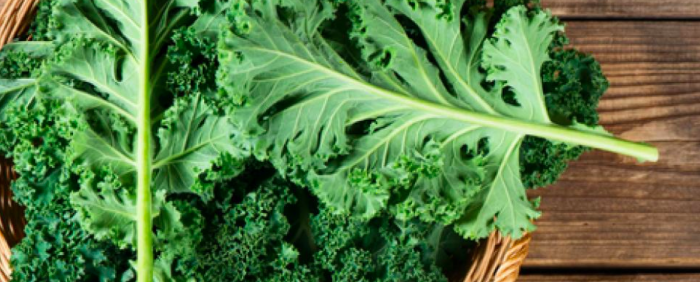
History of Kale
Consumed since Roman times, it became a food widely used in the Middle Ages and then be brought by the English in 17 th century in North America.
Nutritional value of Kale cabbage
| Per 100 g of raw cabbage | Content |
| Calories | 50 kcal |
| Water | 84.5g |
| Carbohydrates | 10 g |
| Protein | 3.3g |
| Fat | 0.7 g |
| Dietary fiber | 2.4g |
| Vitamin C | 120 mg |
| Calcium | 135 mg |
| Potassium | 447 mg |
| Iron | 1.7 mg |
| Vitamin A | 769 μg |
| Vitamin K | 817 μg |
Health effects of Kale
Vitamin A
Vitamin A requirements for an adult are 700 to 900 μg per day. A 100 g serving of kale therefore provides 80 to 110% of the daily vitamin A requirement. This vitamin plays a key role in eye health but also in bone growth, reproduction, regulation of the immune system, skin and mucous membrane health and iron absorption.
Vitamin C / antioxidants
Kale is a very good source of vitamin C. In addition to its antioxidant role, vitamin C contributes to the maintenance of skin integrity, helps wound healing, protects cells against premature aging caused by free radicals and facilitates immune functions. In addition, it facilitates the absorption of non-heme iron of plant origin. The consumption of 100 g of kale cabbage fills 150% of the daily requirements of vitamin C.
Kale is also rich in flavonoids, sulforaphane and indole-3-carbinol, substances with strong antioxidant potential 2-3 .
Calcium
Calcium is the most abundant mineral in the human body. It therefore plays an important role in bone health, muscle contraction, regularization of blood pressure, wound healing and transmission of nerve impulses. Even if we know that plant-based calcium has a lower absorption rate than calcium contained in dairy products, kale remains an interesting source of calcium especially for those who consume little dairy product, those with a lactose intolerant or who are vegetarians or vegans.
Potassium
Kale is also a good source of potassium. Like sodium, potassium is an essential mineral that performs several necessary functions in the human body. With the help of sodium, it helps maintain the acid-base balance of the body and controls the pH inside cells. It is also essential for the transmission of nerve impulses, for muscle contraction, it participates in the proper functioning of the kidneys and adrenal glands and also in protein synthesis and carbohydrate metabolism. In addition, sufficient potassium intakes are associated with a reduced risk of cardiovascular disease 4 .
Vitamin K
Vitamin K is associated with the prevention of osteoporosis and also participates in the blood clotting process. Daily vitamin K requirements are 90 to 120 μg per day, while 100 g of kale cabbage provides 817 μg.
Using Kale Cabbage
Kale is generally sold in the form of a bunch. You should choose firm leaves without spots and bruises. It can be kept in the refrigerator for up to two weeks, in the coldest part, having previously washed it with water and dried the leaves.
This type of cabbage is eaten cooked or raw. The inner leaves of the boot are more tender and less tasty while the outer leaves are more fibrous with a more pronounced taste.
Raw, its leaves are leathery and tastier but can be added to salads. By kneading the leaves with vinaigrette, they become more flexible. It can also be added raw to smoothies. However, you must have a mixer powerful enough to reduce the stems and leaves to a smooth mash. It goes very well with mango, pineapple, citrus, avocado and sesame.
Cooked, the leaves can be sautéed in olive oil or steamed for 20 to 30 minutes and then added to pasta dishes, omelettes, soups and stir-fries. It can even be used as a basic ingredient to make a pesto. You can even make potato chips!
A word from the nutritionist
Kale is definitely in the “superfoods” category. It is full of essential nutrients for overall health and helps meet daily needs for many vitamins and minerals but also fiber. Due to its very high antioxidant potential, it should be part of everyone’s daily diet.